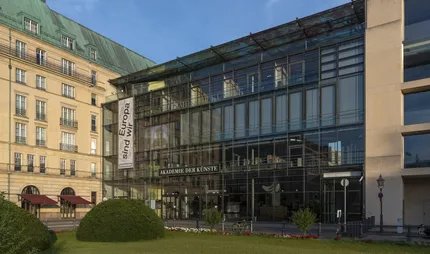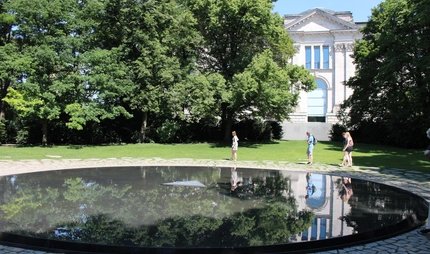
Max Liebermann Haus at the Brandenburg Gate
Reflecting two centuries of German history and art
The Max Liebermann Haus may be one of the quieter places on Pariser Platz. However, its special history and modernised reconstruction make it well worth a visit. Here you can experience historical and current exhibitions.
The Max Liebermann Haus - a classicist building dating from 1844 - blends almost inconspicuously into the Brandenburg Gate ensemble. For reasons of symmetry, it has an architectural twin on the left-hand side of the gate. To the right of the gate, seen from Pariser Platz, is the house where the famous Berlin impressionist Max Liebermann (1847-1935) lived and painted.
The history of the house
The building has been owned by the Liebermanns since 1857. Max Liebermann and his family moved into one of the flats in 1892. The house was one of Berlin's cultural and intellectual centres from the 1920s to the early 1930s. Many famous contemporaries visited Liebermann in his glass-roofed studio. Liebermann developed into one of the most important German painters and also became president of the Berlin Akademie der Künste. Incidentally, this can also be found today on Pariser Platz, diagonally opposite.
Dramatic twists and turns
During National Socialism, Liebermann was banned from working due to his Jewish origins. He died in 1935 and his wife Martha escaped the threat of deportation to the Theresienstadt concentration camp in 1943 by freezing to death. In the same year, the house was destroyed in a bombing raid.
Reconstruction and arrival of the Brandenburg Gate Foundation
After the fall of the Berlin Wall, the building was rebuilt. The interior was modernised, but the exterior was based on the historical model. Today, current art can once again be seen in the "Liebermann Studio" in the spirit of the painter.
The Brandenburg Gate Foundation of Berliner Sparkasse has been based in the Max Liebermann Haus since 2000. The building plays a central role in its programme, on the one hand as a place of remembrance of German history, and on the other as a space for contemporary art, ideas and discourse. The foundation sees it as its mission to emphasise the importance of culture for our society at this historic site. Exhibitions, projects, lectures, conferences and other event formats serve this purpose. The "Aesthetic Education" area was created especially for children and young people. The focus here is on early encounters with art and culture.
Your visit
How to get there: Brandenburger Tor S + U station
The museum attracts visitors with affordable admission prices. Visitors under the age of 18 can enter free of charge. The building is partially barrier-free.
Around the Brandenburg Gate
The Straße des 17. Juni lies on one side of the Brandenburg Gate and Boulevard Unter den Linden on the other. The Reichstag and the Memorial to the Murdered Jews of Europe are important sights in the immediate vicinity. It is also not far to Potsdamer Platz.
A detour to the Wannsee
A visit to the Liebermann-Villa in Berlin-Wannsee. In the beautiful gardens and bright exhibition rooms, the great artist seems close enough to touch.



